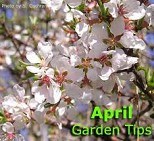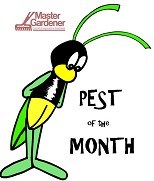Do your flowering plants have leaves and flowers with holes chewed in them? Do you have entire plants that have been chewed down to the ground? It takes a little investigative work to find out what exactly is eating the garden. The first thing to do is to look carefully at the damage and at any signs left behind.
Damage may be caused by an animal such as a rabbit or woodchuck if, in a short period of time:
- Large parts of the plant are chewed off
- New growth is uniformly nibbled off
- Plants are eaten to the ground.
It is no secret that rabbits love petunia flowers and will nibble away at flowers and new growth. Woodchucks tend to leave trampled plants in the process and feed during the daylight close to their burrows. To determine if an animal is causing the damage, sprinkle a layer of fine ground limestone around the plants and look for animal tracks left in the powder the next day.
If the damage has been occurring slowly with a little feeding each night, caterpillars, slugs or beetles may be the culprits. To distinguish between these three look for signs left behind. Caterpillars leave fecal droppings under the leaves or around the damage. Droppings look like small pellets.
Slugs will leave a slime trail as they feed, which dries into a shiny trail. The slime helps protect their bodies from desiccation and is a sign left behind.
To investigate further, look for pests at dusk. Slugs and many caterpillars and beetles (e.g. Asiatic garden beetle) feed at night and hide during the day. Dusk is also a good time to treat for active pests.
Once you have diagnosed the problem you will be able to choose a management strategy. Caterpillars can be managed using a product containing Bacillus thuringiensis (BT) or spinosad, both natural ingredients.
To deter animals, fencing or repellents can be used. Ingredients in repellents may include predator animal urine, garlic, sulfur or hot pepper, among others. Check the labels and follow directions.
Slugs can be managed using slug baits or trapping. Baits that contain iron phosphate are effective and reportedly are sale to use around pets and wildlife. Slugs consume the iron, a heavy metal which is toxic to them, become less mobile and begin to die within three to six days. Slugs can also be easily trapped by laying boards down in the garden at night. The slugs attach themselves under the board where they can easily scraped off during the day. Copper strips are another option. Copper placed around the garden acts as a repelling barrier. The copper emits a small electrical charge that repels slugs.
To manage beetles, consider a long-term management effort. Begin by grub-proofing the lawn where the grub stage of the beetles feed on grass roots. Also, while you can treat adult beetles with an insecticide, note that many gardeners find that treating for adults is a futile effort. Common beetles are Japanese beetles, Oriental beetles, Asiatic garden beetles, European chafers and rose chafers.
By first identifying the problem, you can choose the best management option and use fewer pesticides in your garden.
For information about many gardening topics, including pests, visit www.cce.cornell.edu/gardening
Submitted by CCEFM Master Gardeners
Source: Tina Smith, University of Massachussetts Extension




